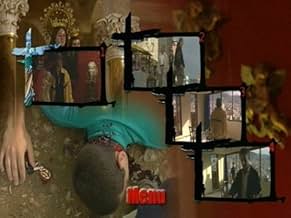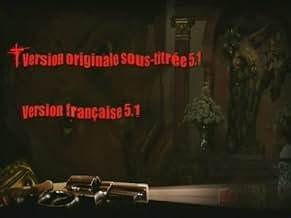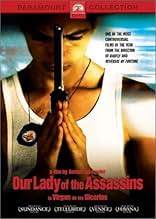IMDb RATING
6.8/10
4.4K
YOUR RATING
The writer F. Vallejo returns to Medellin after an absence of over 30 years. He meets 16-year-old Alexis. Alexis is the kind of killer who knocks people off on command. The two are immediate... Read allThe writer F. Vallejo returns to Medellin after an absence of over 30 years. He meets 16-year-old Alexis. Alexis is the kind of killer who knocks people off on command. The two are immediately attracted to each other.The writer F. Vallejo returns to Medellin after an absence of over 30 years. He meets 16-year-old Alexis. Alexis is the kind of killer who knocks people off on command. The two are immediately attracted to each other.
- Awards
- 3 wins & 3 nominations total
Featured reviews
10jvframe
Our Lady Of Assassins showed at the Brisbane International Film Festival. It left me initially distraught and other members of the audience obviously felt the same. After a bit of thought, I realised that it was indeed a powerful and beautifully created way of presenting the desperate nature of life in Medellin. The main character, who was born and raised in the town, remembers how potentially violent it was even 40 years earlier, yet seems to be shocked by how much it has decayed. It is strange that he is also quite complicit in inciting violence, while seeming to be just looking for love.
The film forces the audience to question the day to day value of life and just how much violence we can allow ourselves to tolerate. But in Medellin the solution is certainly not in the hands of just one person.
A great trio of films showing the broad story of the cocaine phenomena would be "Our Lady Of Assassins", Ted Demme's "Blow" and "Traffic".
The film forces the audience to question the day to day value of life and just how much violence we can allow ourselves to tolerate. But in Medellin the solution is certainly not in the hands of just one person.
A great trio of films showing the broad story of the cocaine phenomena would be "Our Lady Of Assassins", Ted Demme's "Blow" and "Traffic".
Medellin is a dangerous city in more ways than one is lead to believe. At the time of the action, Pablo Escobar's empire has been dismantled and his loyal soldiers are scattered all around the city engaging in a game of death, revenge and petty vendettas. There is no reverence for life in a place that has seen violence on a daily basis and where children have access to guns for protection in order to survive in that environment.
Barbet Schroeder, the German director, expands on Fernando Vallejo's novel, which the author adapted for the screen, resulting in a highly violent and bloody film that is disturbing, as well as true.
Fernando, the older gay man who comes back to his native city of Medellin, quickly finds a boy to satisfy his needs. Alexis, the young man, is seen at first at the all-male brothel where he is offered by the pimp to Fernando. Alexis turns out to be something the older man didn't expect. This is a boy that is savvy in the ways of how to survive in the city, who clearly takes an interest in the older, and richer Fernando.
Alexis is a marked man and it's only a matter of time; his days are numbered because there are other youths behind him that will do whatever in their power to eliminate him. Fernando can't believe what his city has become, but he has no desire to go away again. When Alexis is killed, Fernando mourns his death until Wilmar, another young gay man appears in his orbit. Little prepares Fernando to realize who Wilmar is really.
Fernando's comments on the situation in his city, as well as in the Colombian reality, are the basic themes of the film. While one side of him cries for that old place he knew as a child, he welcomes this new metropolis full of danger and people that attracts and repulses him at the same time.
German Jaramillo appears to be the alter ego for the writer, Fernando Vallejo, whose story seems to resemble that of the Fernando in the novel and in the film. Mr. Jaramillo's take on Fernando keeps him away from the confrontations between his young lovers and what he thinks is right. He never passes judgment on what the young people are doing, yet he is instrumental for providing the bullets that Alexis needs to defend himself. The other two young actors, Anderson Ballesteros and Juan Diego Restrepo, play Alexis and Wilmar respectively.
Barbet Schroeder has directed the film with all its realism showing us a society in which all hope seems to have abandoned the citizens of the city.
Barbet Schroeder, the German director, expands on Fernando Vallejo's novel, which the author adapted for the screen, resulting in a highly violent and bloody film that is disturbing, as well as true.
Fernando, the older gay man who comes back to his native city of Medellin, quickly finds a boy to satisfy his needs. Alexis, the young man, is seen at first at the all-male brothel where he is offered by the pimp to Fernando. Alexis turns out to be something the older man didn't expect. This is a boy that is savvy in the ways of how to survive in the city, who clearly takes an interest in the older, and richer Fernando.
Alexis is a marked man and it's only a matter of time; his days are numbered because there are other youths behind him that will do whatever in their power to eliminate him. Fernando can't believe what his city has become, but he has no desire to go away again. When Alexis is killed, Fernando mourns his death until Wilmar, another young gay man appears in his orbit. Little prepares Fernando to realize who Wilmar is really.
Fernando's comments on the situation in his city, as well as in the Colombian reality, are the basic themes of the film. While one side of him cries for that old place he knew as a child, he welcomes this new metropolis full of danger and people that attracts and repulses him at the same time.
German Jaramillo appears to be the alter ego for the writer, Fernando Vallejo, whose story seems to resemble that of the Fernando in the novel and in the film. Mr. Jaramillo's take on Fernando keeps him away from the confrontations between his young lovers and what he thinks is right. He never passes judgment on what the young people are doing, yet he is instrumental for providing the bullets that Alexis needs to defend himself. The other two young actors, Anderson Ballesteros and Juan Diego Restrepo, play Alexis and Wilmar respectively.
Barbet Schroeder has directed the film with all its realism showing us a society in which all hope seems to have abandoned the citizens of the city.
I saw the film at the Jerusalem Film Festival. It was a rather late screening, but the viewers were glued to their seats. It's a very gripping movie and extremely subversive in themes, language and visuals. It's very anti current-day Colombia, and no wonder the production didn't go very smoothly. Still I admire the support the film got from `official' institutions in Medellion. It's subversive in themes, because we basically have a gay couple, an older man (about 40-50) who indulges in having sex with minor boys (who do this willingly, and yet, it's rather shocking to the average viewer) in return for financial support, or rather indulging the boys in whatever they want to do. The couple goes around the city and is critical of every facet of the city and rightly so yet the tone is overtly cynical and `evil'. The lead boy, Alexis, goes around and kills whomever is threatening him and his sugar-daddy I think he executed 4 people once a confrontation was about to happen, and 4 more were other kids who were after him. S this shooting spree is depicted in a somewhat accepting manner, as if this is the way to do these things in Colombia. They ridicule almost every aspect of life church, police, government, the drug lords, poor and beggars, the bourgeoisie, other gays, and even themselves. In that respect, it's a very Pasolini movie, although the realism here is a real one and not made for the sake of a socialist agenda. The writer and his two boy-lovers are very lost, although they always know where they are, and the ending is pretty bad, as expected. The film shows no hope for the Colombian people, as they are stuck in a country ran by corrupt officials, gangs and drug lords. The writer has great lines, one of my favorite was about him hating people who whistle, because they shouldn't try and imitate the art that was given to the birds
A good movie, with a 7/10 as far as I can say. Acting-wise since I don't speak Spanish, it was credible to my ears, though the boys did seem to quote their lines mechanically at times.
Prepared as we are for the image of Columbia that CNN shoves down our throats- full of Narcos, Paracos and desperate politicians-, there is no way to predict the surreal way of life the characters in this movie pass through. This is a film that penetrates into a very real Medellin, where nothing is certain and everything is so vulnerable that human life seems to exist only the instant in which it takes place. Medellin is like Fernando- the main character-, it is like his way of walking through a church in the feverishly catholic ambient of Latin America with his sixteen year old murderer lover- who is actually more like an angel fallen from grace. Alexis- the young shooter- is the result of a less than miserable way of life, where poverty and violence rape viciously at each other, almost to a point of neutralization, what seems perverse is in the end the most innocent. This film is strong and profound, it should be forced on all news spokesmen with Colombian corpses in the background: `Lady this is Medellin, not Switzerland'.
Occasionally venturing into dreamlike surrealism, the movie mostly hits you with a heavy dose of cinema verite. The movie is about the city of Medellin in the same way that Midnight Cowboy is about New York. The characters aren't dealing with the problem of staying human in a huge metropolis, but staying human in the midst of instability that verges on anarchy.
The effects of fifty years of civil war aggravated by narcotrafficking and the associated crime are shown in two ways, which are the central themes of the film: the shift from the old and traditional to the modern, and the loss of value that human life has suffered. The banality of the several killings in the movie drives home the second, and the explorations that Fernando and his two boyfriends (sequential, not simultaneous) take through the city show the first.
The movie is violent like the Godfather is violent: the killings are not gratuitous, they are there to make a point. As a document of life in an industrial Andean city which just happens to be the second city of the country poised to become the next Vietnam, or better said, the next El Salvador, La virgen de los sicarios is excellent. It is sophisticated in its writing and its photography. The characters are human and complex. It ought to be in far wider release than just one screen in the whole L.A. area - which happens to be on the West Side, where Spanish-speaking people typically don't live.
The effects of fifty years of civil war aggravated by narcotrafficking and the associated crime are shown in two ways, which are the central themes of the film: the shift from the old and traditional to the modern, and the loss of value that human life has suffered. The banality of the several killings in the movie drives home the second, and the explorations that Fernando and his two boyfriends (sequential, not simultaneous) take through the city show the first.
The movie is violent like the Godfather is violent: the killings are not gratuitous, they are there to make a point. As a document of life in an industrial Andean city which just happens to be the second city of the country poised to become the next Vietnam, or better said, the next El Salvador, La virgen de los sicarios is excellent. It is sophisticated in its writing and its photography. The characters are human and complex. It ought to be in far wider release than just one screen in the whole L.A. area - which happens to be on the West Side, where Spanish-speaking people typically don't live.
Did you know
- TriviaGiven the fact that Anderson Ballesteros did a great job portraying a tough hitman with street knowledge, all the roles he got later were pretty much the same, for example, playing as Pablo Escobar's main hitman on "El Patrón del Mal"
- How long is Our Lady of the Assassins?Powered by Alexa
Details
- Release date
- Countries of origin
- Official site
- Languages
- Also known as
- Our Lady of the Assassins
- Filming locations
- Production companies
- See more company credits at IMDbPro
Box office
- Gross US & Canada
- $525,330
- Opening weekend US & Canada
- $56,069
- Sep 9, 2001
- Gross worldwide
- $624,525
- Runtime1 hour 41 minutes
- Color
- Sound mix
- Aspect ratio
- 1.78 : 1
Contribute to this page
Suggest an edit or add missing content

























